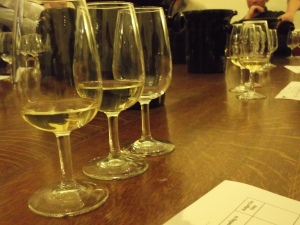Recently, the Oxford Blind Tasting Society was very privileged to host Jan Konetzki, Head Sommelier at three-Michelin-starred Restaurant Gordon Ramsay and winner of the Moët UK Sommelier of the Year 2012. As a sommelier, you not only have to put together a restaurant’s wine list, price the wine sensibly, and be able to sell wine to customers, but you need to understand which wine to recommend to people to go with their food. Gone are the days when you can just go with the “classics”, people want new and exciting wines nowadays, and wines which are interesting. Given my interest in food and wine pairing, I was excited to see which wines he brought, and to pick his brain on food-wine matching.
The wines he bought did not disappoint. I think it’s fair to say that they were a bit off-the-beaten-track, with the most mainstream probably being an Austrian Blaufrankish. Other wines included a Riesling from Sicily, built on the volcanic soils of Mount Etna, a Sangiovese from Australia (a grape variety that is almost exclusively grown in Italy), and a beautiful sweet wine from Jurançon in France. Needless to say we weren’t guessing many of the wines correctly, but it was really fun to try and figure these out.
What was particularly interesting were some of the common themes of these wines. All of them were reasonably “complex”, in that they had many different things going on, but a few qualities stood out. Firstly, all of the wines had relatively high acidity. Acidity helps a wine cut through the fat in food, and at a top restaurant, for rich sauces and high-quality cuts, acidity will be key. Secondly, most of the wines had seen a small amount of oak, even wines typically not oaked- like the Riesling. Perhaps this makes the wine more robust, and gives it an extra dimension with the food. Lastly, was that all the wines had a herbal quality, or some “greenness”. This might provide a different seasoning to the food. Unfortunately we didn’t get to try any food with the wines, but I will look for some of these qualities in the future.
Jan also shared some thoughts on serving wine, something I had not given large amount of though to before. Particularly, he was focused on the temperature of the wine. On the night of our tasting, he was moved wines around the fridge and asked for some warm water just to warm the wines up a couple of degrees before serving. He noted that there is around 4 degrees difference between a fridge door and the back of the fridge, which makes a big difference in changing the wine characteristics. Aromatic wines like Riesling want to be cooler than average, and oakier wines slightly warmer than average. By changing the temperature of the wine, you change how it expresses itself. Jan thought temperature was more important than wine glass shape, and considering he had over 20 different wine glass shapes available at the resaurant, that says a lot.
After the tasting, we had some discussion on food-wine pairing. When asked what part of the dish he looked at first, Jan (perhaps unsurprisingly) was focused on the dish as a whole, but then spent a lot of time discussing seasoning. How prominent each flavour is, and how it develops in the dish, largely factor into the wine choice. Similarly, how cooked the meat would be (even in a good restaurant, people would like the meat well-done), would change slightly how fatty the meat was, with a less-cooked cut having more fat. All little things which changed the character of the dish.
Lastly, the discussion turned to cheese. “Cheese kills everything”, a popular opinion, was confirmed by Jan. However, you are not totally lost. He supported the idea of regionality, so if you are stuck with a pairing, picking a wine from the same region as the cheese is often not a bad call. He wasn’t so keen on red wines with cheese though. Interestingly, fortified wines played a big part here, suggesting a sherry with mimolette, and indeed that a nice glass of Madeira will keep most people happy with cheese. But, as was the underlying theme throughout the evening, the food-wine pairing was about what the customer liked- if the customer wants a wine a certain way, that’s fine. Experiment with what you like, and find out what works for you.
If you are interested in food-wine pairings, check out my other posts on food-wine pairings, The Blind Tasting Black Tie Dinner, Wines for a Wedding, Creating a meal around sweet wines, and Regionality. Also, The Wine Society has a great section on food-wine pairings, and a good food-wine matcher.


